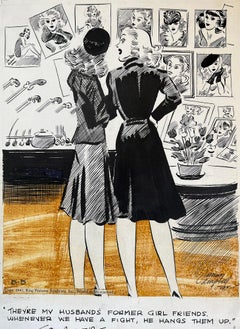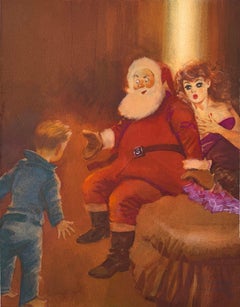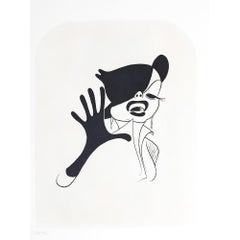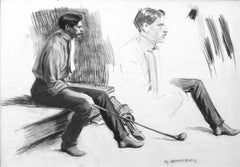E. Simms Campbell Portrait Drawings and Watercolors
American, 1906-1971
Elmer Simms Campbell (January 2, 1906 – January 27, 1971) was an American commercial artist best known as the cartoonist who signed his work, E. Simms Campbell. The first African-American cartoonist published in nationally distributed, slick magazines, he created Esky,the familiar pop-eyed mascot of Esquire. Campbell was born in St. Louis, Missouri, the son of educators, Elizabeth Simms Campbell & Elmer Campbell
He then enrolled in the University of Chicago. After one year, Campbell left the University of Chicago and transferred to and received his degree from the Chicago Art Institute.
He spent two years at Triad Studios before moving to New York City in 1929. taking classes at the National Academy of Design. During this time, he contributed to various magazines, notably Life, & Judge.
Following the suggestion of cartoonist Russell Patterson to focus on good girl art, Campbell created his "Harem Girls", a series of watercolor cartoons that attracted attention in the first issue of Esquire, debuting in 1933. Campbell's artwork was in almost every issue of Esquire from 1933 to 1958 & he was the creator of its continuing mascot, the cartoon character in a silk top hat.
He also contributed to The Chicagoan, Cosmopolitan, Ebony, The New Yorker, Playboy, Opportunity: A Journal of Negro Life, Pictorial Review, and Redbook.
His commercial artwork for advertising included illustrations for Barbasol, Springmaid,Hart Schaffner & Marx.
Campbell also was the author of a chapter on blues music in the 1939 book Jazzmen, a seminal study of jazz's history and development.
Campbell died in White Plains, New York, in 1971
His gag panel, Cuties, was syndicated by King Features in more than 145 newspapers "A Night-Club Map of 1930s Harlem"
Of enduring cultural & historical interest is the witty, cartoon-filled map Campbell drew in 1932 – "A Night-Club Map of 1930s Harlem" identifying the attractions of Harlem during the Harlem Renaissance and adding his personal notes. He captures the intensity of the scene: within a few blocks of each other he has cartooned Cab Calloway singing at the Cotton Club, Bill "Bojangles" Robinson doing his step dance at the Lafayette Theater – "Friday night is the Midnight show, Most Negro revues begin and end here." Lissome "cafe au lait girls" dance at Small's Paradise. Outside, doormen welcome White swells in top hats, while an elegant Black couple in evening dress dance "the Bump"
Campbell's map appears in the book version of Ken Burns's documentary Jazz. The map in its entirety also appears as the inside front cover of "Of Minnie the Moocher and Me", the autobiography of Cab Calloway by Cab Calloway and Bryant Rollins (TY Crowell, 1976). Jazz historian Mike Thibault reports that the original was displayed by the Smithsonian in 1996.The map is currently held at the Yale Beinecke Rare Book & Manuscript Library.
On April 4, 2017, National Geographic published an article on the map that included the map and several enlarged sections of it. They featured it again during 2020 to subscribers of their newsletter, among a collection of unique maps of New York City.
Recognitionto
2
Overall Width
to
Overall Height
to
2
1
1
1
2
2
2
2
1
1
1
1
1
1
2
1
1
1
1
6
203
72
60
51
2
Artist: E. Simms Campbell
My Husbands Former Girl Friends - First Black Illustrator/ Black Cartoonist
By E. Simms Campbell
Located in Miami, FL
Cuties Cartoon Strip - E. Simms Campbell
My Husband Former Girl Friends - First Black Illustrator/ Cartoonist,
Category
1940s Contemporary E. Simms Campbell Portrait Drawings and Watercolors
Materials
Ink, Board
Santa Claus Sexy Playboy Cartoon First African American Illustrator, Elmer Simms
By E. Simms Campbell
Located in Miami, FL
Santa has a quickie with Mom.
Elmer Simms Campbell was the first African American Illustrator to work for major newsstand magazines.
Published December, 1963
Signed in pencil lower...
Category
1960s Realist E. Simms Campbell Portrait Drawings and Watercolors
Materials
Watercolor, Illustration Board, Pencil
Related Items
"Judy Garland" Legendary Film and Recording Star. Gay Icon. 20th Century Litho
By Albert Al Hirschfeld
Located in New York, NY
"Judy Garland" Legendary Film and Recording Star. Gay Icon. 20th Century Litho
Al Hirschfeld (1903 - 2003)
Judy Garland
20 x 15 inches (sight)
Etching
26 1/2 x 14 3/4 inches Framed...
Category
1970s Performance E. Simms Campbell Portrait Drawings and Watercolors
Materials
Ink, Board
Early 20th Century Young Golfer Figurative
By Margaret Neilson
Located in Soquel, CA
Study of a young man with his golf clubs by listed artist Margaret Neilson Armstrong (American, 1867-1944). Image, 14"H x 20"W. Displayed in vintage mat. S...
Category
1920s Realist E. Simms Campbell Portrait Drawings and Watercolors
Materials
Paper, Pencil
Head of Medusa
Located in Indianapolis, IN
Titled and signed lower center and right.
Category
20th Century E. Simms Campbell Portrait Drawings and Watercolors
Materials
Clay, India Ink, Board
Neoclassical composition of a sculptor kneeling before his statue of the Madonna
Located in Middletown, NY
An allegory of loyalty, with the subject's dog pictured seated, holding his master's chisel in his mouth; fidelity personified.
Italian School, 18th century
Ink wash in gray and bl...
Category
Mid-18th Century Italian School E. Simms Campbell Portrait Drawings and Watercolors
Materials
Laid Paper, Ink, Watercolor
$500
H 9.73 in W 7.01 in
Original TV Guide Illustration Caricature Esther Williams John Raitt Dinah Shore
By Albert Al Hirschfeld
Located in New York, NY
Original TV Guide Illustration Caricature Esther Williams John Raitt Dinah Shore. Published December 25, 1957 in TV Guide as an editorial to promote the Di...
Category
1950s Performance E. Simms Campbell Portrait Drawings and Watercolors
Materials
Ink, Board
$12,000
H 15 in W 22 in D 2 in
Self Portrait 02 - Modern Figurative Watercolor Painting, New Expressionism
By Maciej Olekszy
Located in Salzburg, AT
The artwork on paper will be sent unframed to you.
Maciej Olekszy was born in 1982, Poland. Graduated from the Academy of Fine Arts in Poznan, Poland in 2007. Faculty of Painting i...
Category
2010s Contemporary E. Simms Campbell Portrait Drawings and Watercolors
Materials
Paper, Watercolor
$1,423
H 41.34 in W 29.53 in
Original Judy Garland Get Happy Drawing. Legendary Star. Caricature. Not a Litho
By Albert Al Hirschfeld
Located in New York, NY
Original Judy Garland Get Happy Drawing. Legendary Star. Caricature. Not a Litho.
Al Hirshfeld (1903-2003)
Judy "All Star Variety" Garland at the Palace
Ink on board, 1955
Sight: 16...
Category
1950s Performance E. Simms Campbell Portrait Drawings and Watercolors
Materials
Ink, Board
Mission Impossible Original TV Guide Drawing Illustration Caricature Mid Century
By Albert Al Hirschfeld
Located in New York, NY
"Mission Impossible" Original TV Guide Drawing Illustration Caricature Mid Century NYC with Greg Morris, Barbara Bain, and Steve Hill. This original drawing...
Category
1960s American Modern E. Simms Campbell Portrait Drawings and Watercolors
Materials
Ink, Board
"Marc Chagall" Original Drawing Illustration Caricature William Saroyan book
By Albert Al Hirschfeld
Located in New York, NY
"Marc Chagall" Original Drawing Illustration Caricature William Saroyan book
This drawing was published in the 1976 edition of William Saroyan's SONS ...
Category
1970s American Modern E. Simms Campbell Portrait Drawings and Watercolors
Materials
Ink, Board
$14,000
H 21.625 in W 14.75 in
Bette Midler Legendary Film and Recording Star. Gay Icon. 20th Century Litho
By Albert Al Hirschfeld
Located in New York, NY
Bette Midler Legendary Film and Recording Star. Gay Icon. 20th Century Litho
Al Hirschfeld (1903 - 2003)
Bette Midler
15 x 11 inches (sight)
Etching
22 x 18 inches Framed
Signed an...
Category
1980s Performance E. Simms Campbell Portrait Drawings and Watercolors
Materials
Ink, Board
Sidney Poitier & Tony Curtis Oscar Winning 1958 film The Defiant Ones Caricature
By Albert Al Hirschfeld
Located in New York, NY
"The Defiant Ones" Tony Curtis Sidney Poitier Oscar Winning 1958 film Caricature. Two escaped convicts chained together, one white and one black, must l...
Category
1950s Modern E. Simms Campbell Portrait Drawings and Watercolors
Materials
Ink, Board
$55,000
H 29 in W 36 in D 2 in
Gibson Girls - Set of Two 1920's Portraits, Vintage Fashion Illustrations
Located in Soquel, CA
Gorgeous pair of two 1920's watercolor portraits of Gibson girls, one in blue and one in pink, by Charles Hollman (Dutch, 1877-1953). Each portrait renders...
Category
1920s American Impressionist E. Simms Campbell Portrait Drawings and Watercolors
Materials
Paper, Watercolor
$1,150
H 13 in W 11 in D 2 in
E. Simms Campbell portrait drawings and watercolors for sale on 1stDibs.
Find a wide variety of authentic E. Simms Campbell portrait drawings and watercolors available for sale on 1stDibs. You can also browse by medium to find art by E. Simms Campbell in board, ink, casein paint and more. Much of the original work by this artist or collective was created during the 1940s and is mostly associated with the contemporary style. Not every interior allows for large E. Simms Campbell portrait drawings and watercolors, so small editions measuring 9 inches across are available. Customers who are interested in this artist might also find the work of Darius Steward, Linda Newman Boughton, and David Becker. E. Simms Campbell portrait drawings and watercolors prices can differ depending upon medium, time period and other attributes. On 1stDibs, the price for these items starts at $7,000 and tops out at $7,000, while the average work can sell for $7,000.



